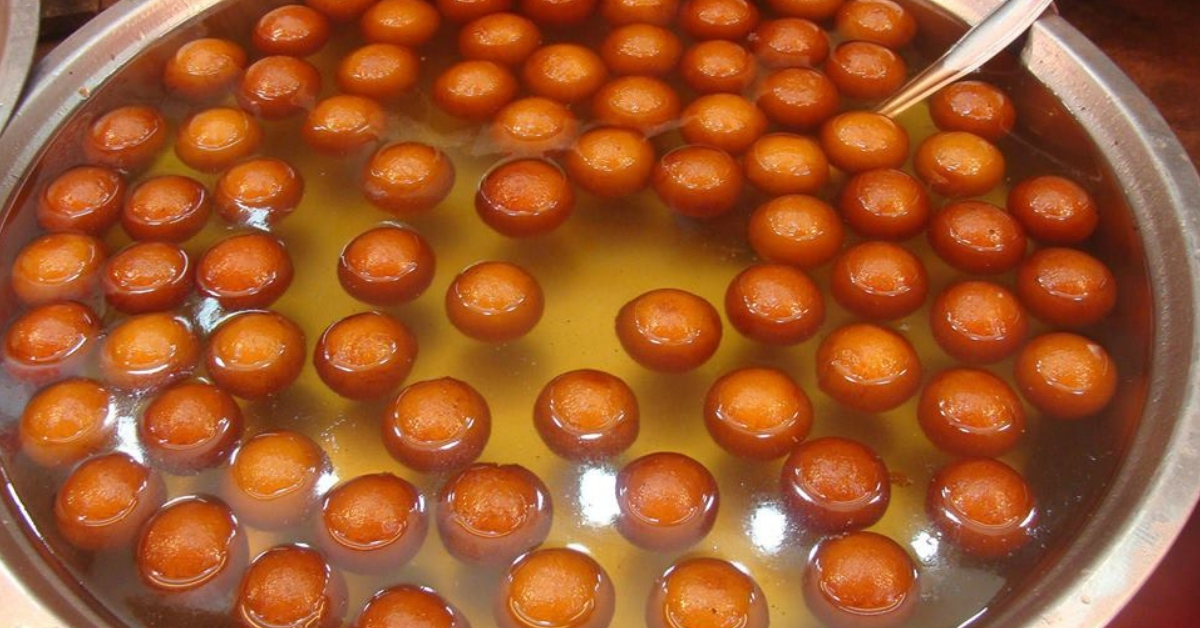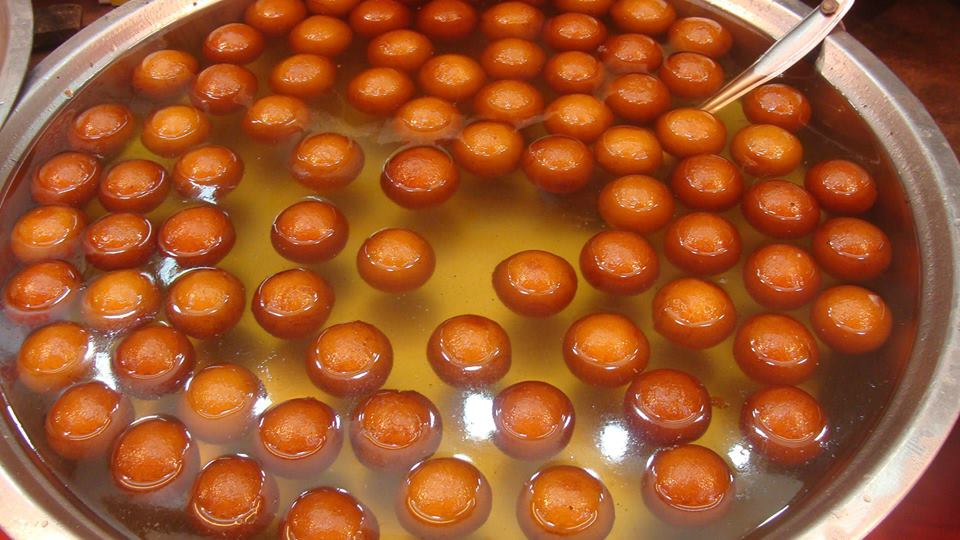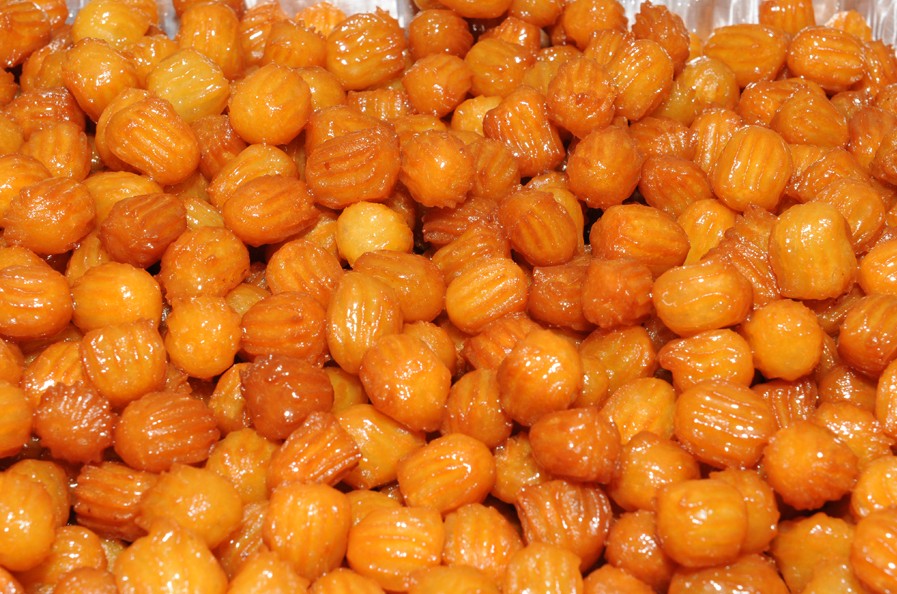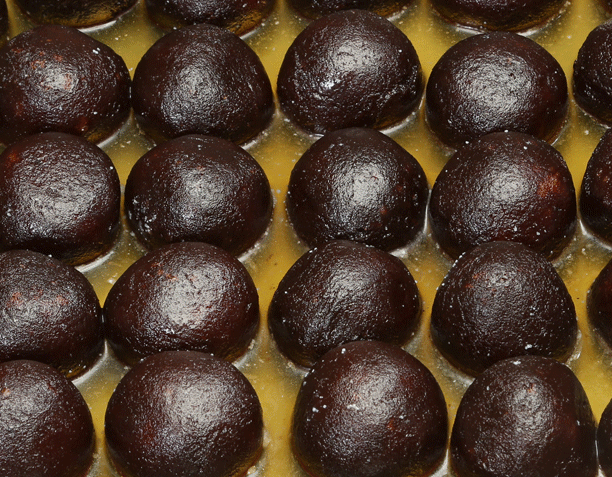The Origin of Gulab Jamun: A Story of History, Tradition & Oodles of Sweetness!
From culinary legends to regional variants, we unravel the fascinating tale of how the gulab jamun become an inevitable part of Indian lives.

Festivals and celebrations without sweets? No can do! From the rasgulla and the modak to jalebi and gajar ka halwa, Indian desserts can make most of us go weak in the knees. However, if there is one desi delight I would pick over all others, it would definitely be the luscious gulab jamun.
Sinful, small fried rounds that smell of warm milk and caramelised sugar, gulab jamuns are ubiquitous in India — nearly every sweet store in the country serves some version of them. In fact, they have been served and savoured so often that most of us have forgotten what it takes to make this sweet truly extraordinary.

Photo Source: Meditag
The perfect gulab jamun calls for meticulously measured ingredients and a practised technique. Made with chenna (or khoya) and kneaded with maida, balls of dough are fried till they turn that elusive rosy shade between gold and brown. After the heated oil works its magic, the crystallised sugar in the batter creates a slightly grainy crust while the jamun‘s white heart remains silky smooth.
Infused with rose-scented (or cardamom-flavoured) chashni, the ball yields to the slightest pressure, literally melting away as one bites into it. As such, the fluffy pillows of warm, syrup-laden dough are as deeply comforting as they are delicious — I could go on and on here.
But with that delectable vision in our minds, its time to unravel the fascinating tale of how gulab jamun become an inseparable part of Indian lives.
History reveals some interesting facts about the origins of this celebrated Indian sweet. Food folklore has it that the gulab jamun was accidentally concocted by Shah Jahan’s royal chef who took inspiration from Persian/Turkish traditions and local halwais.
Interestingly, the Persian bamieh and the Turkish tulumba are both similar to the gulab jamun. They are both fluffy lumps of unleavened dough fried and soaked in sugar syrup. However, unlike the gulab jamun, it is served cold. Nonetheless, it may have been what inspired the Mughal cooks.
Photo Source: Assal Pastry
In his book The Donut: History, Recipes, and Lore from Boston to Berlin, culinary historian Michael Krondl writes about how Persian invaders brought with them a “round fritter that eventually became gulab jamun (gulab comes from the Persian word for rose, while jamun refers to a local fruit).”
He further adds, “The [Indian] recipe is more complex than in the Middle East, requiring a mixture of dried and fresh milk thickened with flour. But as in Iran, the mixture is fried and soaked in rosewater syrup”.
Also Read: Food Fit for Royalty: So What Did The Mughal Emperors Eat For Dinner?
Another theory traces gulab jamun’s origin to the popular Arabic dessert luqmat al qadi, which consists of deep fried dough balls dipped in honey and sprinkled with sugar. The batter, though, is different from the Indian version. Interestingly, the name luqmat al qadi literally translates to “the judge’s morsel” — the sweet is considered delicious enough to sway the opinion of a judge!
Photo Source: Adventuress
Over time, an exchange of customs and cultural ideas led to the evolution of local and hyperlocal variations of the gulab jamun that reflect the gastronomic histories of the particular region.
For instance, the case of Ledikeni, the cylindrical, red-brown dessert from Kolkata whose peculiar name has a sweet legend of its own.
According to the most popular story, in the late 1850s, Calcutta’s ace confectioner Bhim Chandra Nag was asked to prepare a special sweet for Lady Canning — the wife of Governer General Lord Charles Canning (later the first Viceroy of British India) — who was coming to India to be with her husband. And thus, by accident or an act of genius, ledikeni was born.
The sweet treat caught the fancy of Lady Canning, who was so fond of the sweet that the locals soon started referring to it as ‘ledikeni‘ (a mispronunciation of her name). Serving the dessert on all occasions and parties hosted by her, the Viceroy’s wife was also responsible for popularising it across all of Bengal.

Photo Source: Ranna Banna
Interestingly, the state is also home to the pantua, which is basically a mini gulab jamun stuffed with mishri.
Talking of regional variants of the gulab jamun, another interesting one is the dry jamun of Kumbakonam. Created and sold by the family-run Kumbakonam Murari Sweet, the dry jamun has a sugar-dusted, crisper crust and is smaller than its original namesake. It also has a shelf life of a week without refrigeration, making it a must-buy food souvenir if you are travelling to this temple town in Tamil Nadu.
The story of gulab jamun‘s illustrious extended family is incomplete without mentioning its much-loved culinary cousin, kala jaam or kala jamun. This variant gets its signature black-purple colour and crisp texture from the extra sugar that is added to its batter before being deep-fried at a high temperature.
Now that you know the fascinating history of this culinary gem (and perhaps, are craving it too!), here are some places that serve some of the best gulab jamuns in India.
- Delhi: Shiv Misthan Bhandar, Chandni Chowk
- Bengaluru: Bhagathram Sweets, Chats & Fast Food, Commercial Street
- Kolkata: Girish Chandra Dey and Nakur Chandra Nandy, Hatibagan
- Chennai: Shree Mithai, Nungambakkam
- Lucknow: Pandit Ji Ke Dehati Rasgulle, Aliganj
- Hyderabad: Dadu’s Mithai Vatika, Jubilee Hills
- Mumbai: Krishna Gulab Jamun, Khar West
- Ahmedabad: Champaji Gulab Jamun House, Paldi
- Shimla: Baljee’s, Mall Road
TBI Bonus Trivia: Did you that one of Uttar Pradesh’s best-kept secrets is a ‘gulab jamun highway’? Located near Maigalganj village in Lakhimpur district, this half-a-kilometre stretch along the Delhi-Shahjahanpur-Lucknow National Highway 24 is dotted with over a hundred shops selling fresh and fluffy gulab jamuns in earthen plates.
In fact, it has become a ritual for regular commuters along this route to stop, savour and get some of these lip-smacking sweets packed for family and friends!
(Edited by Vinayak Hegde)
Also Read: 20 Delectable Indian Sweets You Probably Haven’t Heard Of, But Must Try Right Away!
Like this story? Or have something to share? Write to us: [email protected], or connect with us on Facebook and Twitter.
NEW: Click here to get positive news on WhatsApp!
This story made me
- 97
- 121
- 89
- 167
Tell Us More
We bring stories straight from the heart of India, to inspire millions and create a wave of impact. Our positive movement is growing bigger everyday, and we would love for you to join it.
Please contribute whatever you can, every little penny helps our team in bringing you more stories that support dreams and spread hope.



















